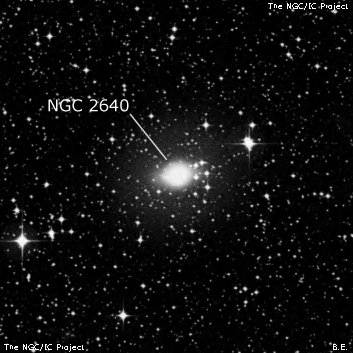
John Herschel, observing with Thomas Maclear (the Astronomer Royal at the Cape Observatory), discovered NGC 2640 = h3134 on 26 Feb 1835. He recorded, "pF; S; R; has 3 or 4 vS stars near it, preceding. Observation taken by Mr. Maclear." Herschel mentioned in his diary that he invited Maclear that night to repeat his "Great Sweep" (#551), which he made on three weeks earlier. He called that experience "the subline of Astronome - a sort of 'ne plus ultra'." Fortunately, the night of the 25th "turned out glorious! Clear as crystal and pure as aether. A finer night for definition was never seen."
Pietro Baracchi recorded "pB; S; R; gbM. 5 small stars from 15 to 16 mag precede closely to the nebula." (10 Jan 1886, Melbourne).
RNGC classified this galaxy as an "unverified southern object", so despite being relatively bright it was not included in the first edition of Uranometria Deep Sky Field Guide nor the Uranometria 2000 Atlas.
300/350mm - 13.1" (2/20/04 - Costa Rica): this Carina galaxy has an unusual appearance. At 166x, it appeared fairly faint, fairly small, elongated 4:3 ~E-W, 1.2'x0.9'. A trio of mag 14 stars is superimposed on the west side of the halo (4 total). The galaxy appears to have a brighter knot or star on the following end. Situated between a mag 10 star 2.2' NW of center and mag 9.3 HD 73851 4.8' SE. Starhopped over from mag 1.9 Delta Velorum located 67' ENE. Also, the galaxy is 2.2° SSW of the naked-eye cluster IC 2391 (surrounding Omicron Velorum).
600/800mm - 24" (4/11/08 - Magellan Observatory, Australia): bright, moderately large, round, 1.2' diameter, sharply concentrated with a very bright 40" core. A group of 5 faint stars is snuggled up against the west side of the galaxy in two N-S parallel rows! Another very faint star is just off the SE side. Located 4.8' NW mag 9.3 HD 73851 and 2.2' SW of a mag 10.5 star
Notes by Steve Gottlieb